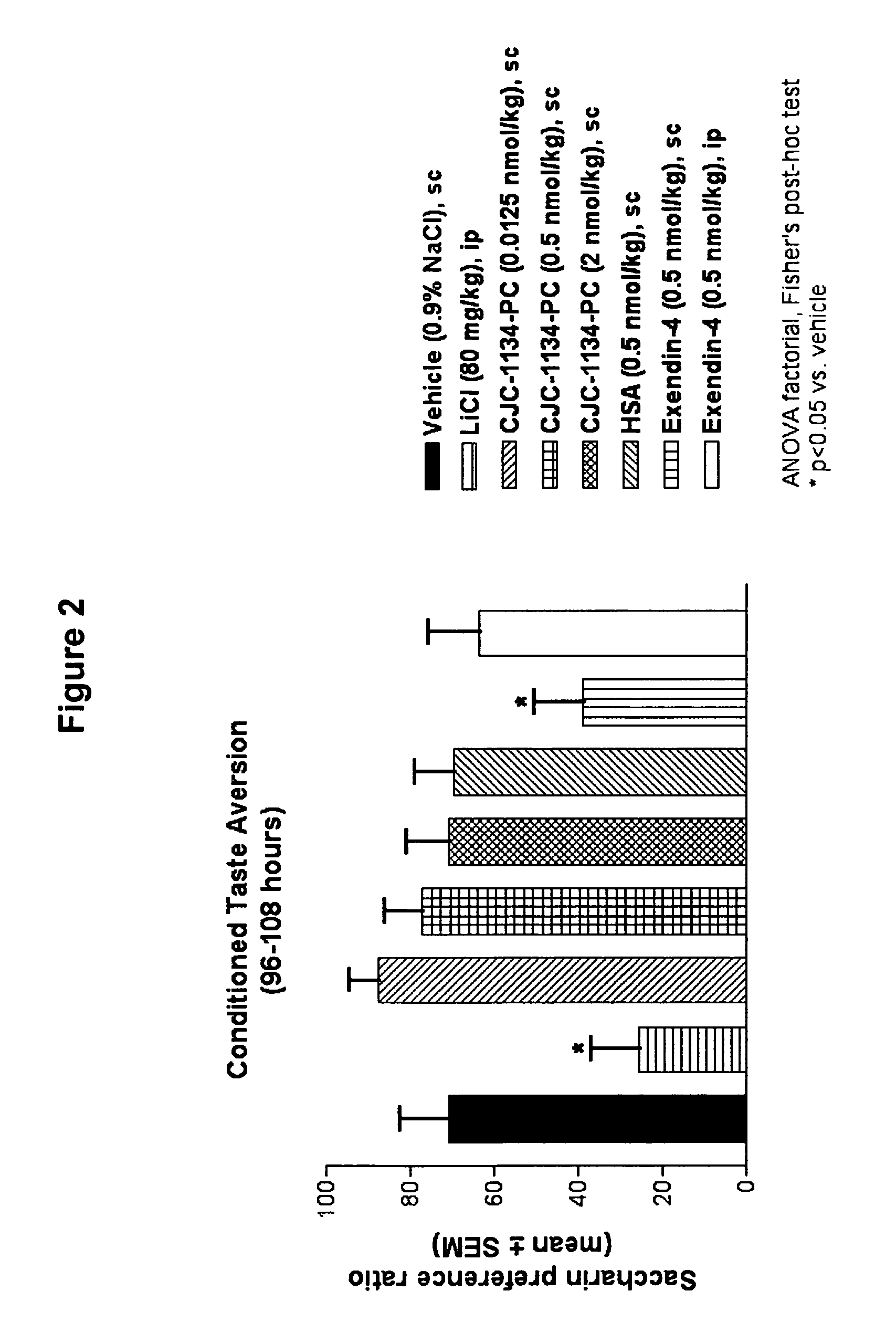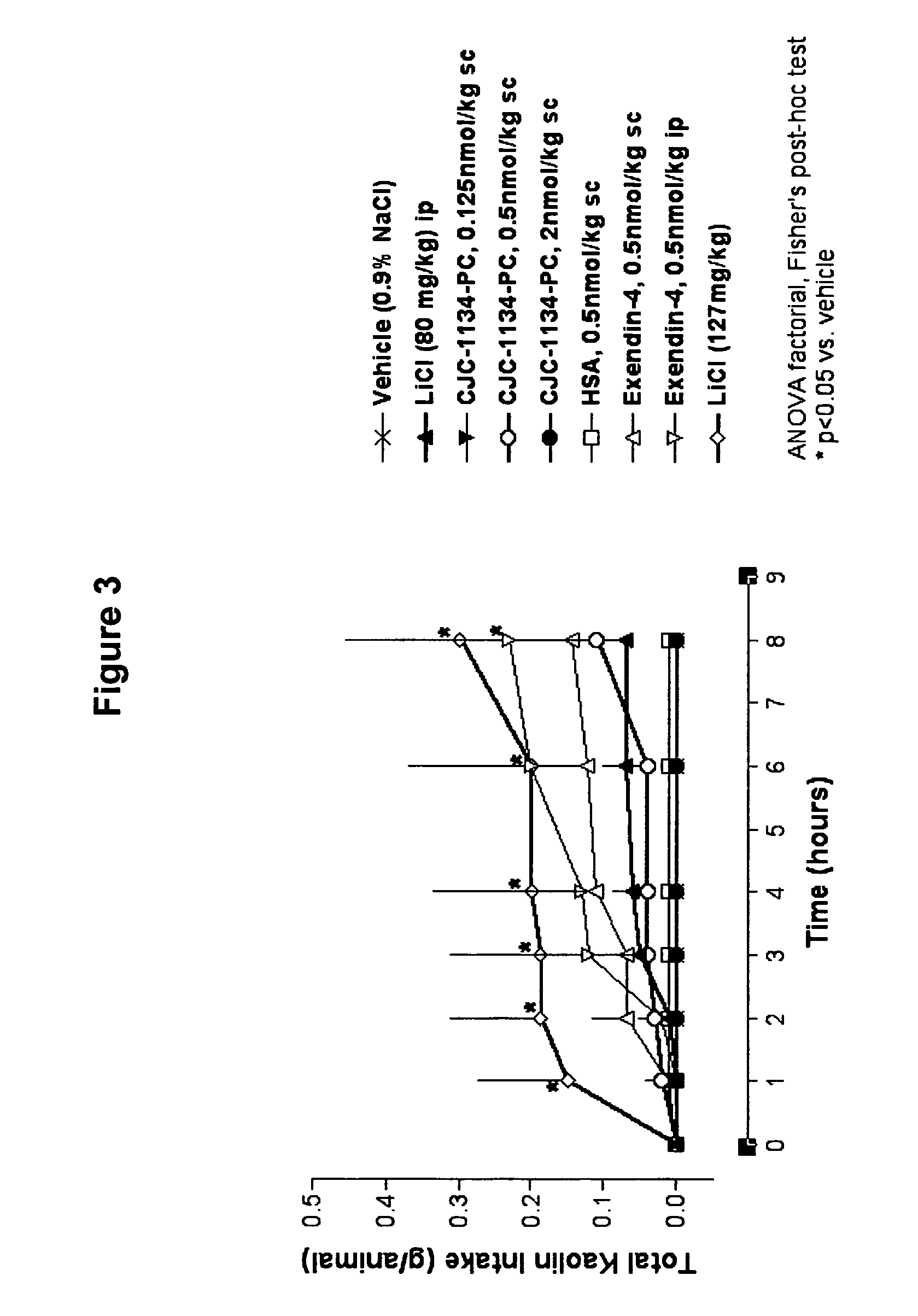Method of treatment of diabetes and/or obesity with reduced nausea side effect
a diabetes and/or obesity side effect and nausea technology, applied in the field of insulinotropic peptides, can solve the problems of nausea side effect, nausea and vomiting in a significant proportion of subjects exposed, and achieve the effects of preventing, reducing, or eliminating nausea side effect, preventing, and reducing nausea side
- Summary
- Abstract
- Description
- Claims
- Application Information
AI Technical Summary
Benefits of technology
Problems solved by technology
Method used
Image
Examples
example 1
6.1 Example 1
Conditioned Taste Aversion Test (CTA)
[0169]One model for studying gastrointestinal malaise in response to administration of a test agent is the conditioned taste aversion test (Peeters and Broekkamp, 1994, J. Steroid Biochem. Mol. Biol., 49:417-427). Conditioned taste aversion is a form of associative learning in which animals learn to avoid flavors of substances where initial ingestion of the substance was followed by illness. In conditioned taste aversion, animals learn to associate a flavor, or conditioned stimulus, with the aversive effects of an administered agent, or unconditioned stimulus. Following conditioned stimulus—unconditioned stimulus pairings, animals reduce their consumption of the conditioned stimulus, and / or show a preference for other tastes when later presented with the conditioned flavor. A conditioned taste aversion test was performed to determine gastrointestinal malaise following administration of unconjugated exendin-4(1-39) versus exendin-4(1-...
example 2
6.2 Example 2
Kaolin Intake
[0173]Another model for assessing gastrointestinal malaise in the rat is the consumption of non-nutritive substances following administration of a toxic agent. Pica, the ingestion of dirt or a non-nutritive clay such as kaolin, is a behavior only observed when rats are thought to be ill. As rats appear to lack an emetic reflex, kaolin ingestion has been used as an indirect indicator of nausea in response to a toxic agent. Accordingly, kaolin ingestion was measured in rats injected with unconjugated exendin-4 versus CJC-1134-PC to assess tolerability.
[0174]Ninety male Sprague-Dawley rats of 6 weeks in age were housed individually and given food and water ad libitum. Habituation to kaolin was achieved by offering fresh blocks of kaolin daily for 8 days before dosing. Rats were then assigned to nine treatment groups (n=10 / group). On the day of dosing (0900 h), rats were given clean cages with minimal bedding, and test agents were administered accordingly: grou...
example 3
6.3 Example 3
Toxicity Studies
[0177]Toxicity of CJC-1134-PC was assessed in 7-day and 28-day studies utilizing both rat and primate subjects. CJC-1134-PC was administered daily by subcutaneous injection.
[0178]6.3.1 Rat Toxicity Study
[0179]For the 7-day study, Sprague Dawley rats were divided into four dosing groups (n=5 / sex / group), and CJC-1134-PC was injected at 0, 1, 5 or 25 mg / kg / day SC. Immediately following injection, rats were housed individually, and food consumption and changes in body weights were monitored. Overall, no mortality or serious signs of toxicity were observed throughout the 7-day period. A dose dependent decrease in food consumption was observed at days 1-3 in rats dosed at 5 and 25 mg / kg / day. However, by day 4, food consumption was similar to that observed in rats receiving vehicle only (FIG. 4). Similar decreases in water consumption and body weight were observed in rats dosed at 5 and 25 mg / kg / day; however recovery was observed by days 3-4. (FIG. 5). There we...
PUM
| Property | Measurement | Unit |
|---|---|---|
| molecular weight | aaaaa | aaaaa |
| molecular weight | aaaaa | aaaaa |
| length | aaaaa | aaaaa |
Abstract
Description
Claims
Application Information
 Login to View More
Login to View More - R&D
- Intellectual Property
- Life Sciences
- Materials
- Tech Scout
- Unparalleled Data Quality
- Higher Quality Content
- 60% Fewer Hallucinations
Browse by: Latest US Patents, China's latest patents, Technical Efficacy Thesaurus, Application Domain, Technology Topic, Popular Technical Reports.
© 2025 PatSnap. All rights reserved.Legal|Privacy policy|Modern Slavery Act Transparency Statement|Sitemap|About US| Contact US: help@patsnap.com



